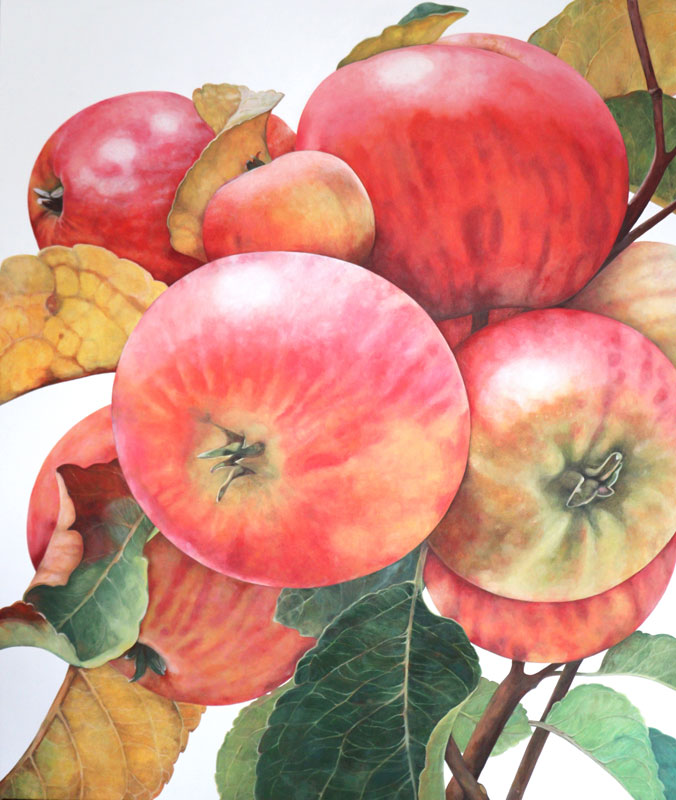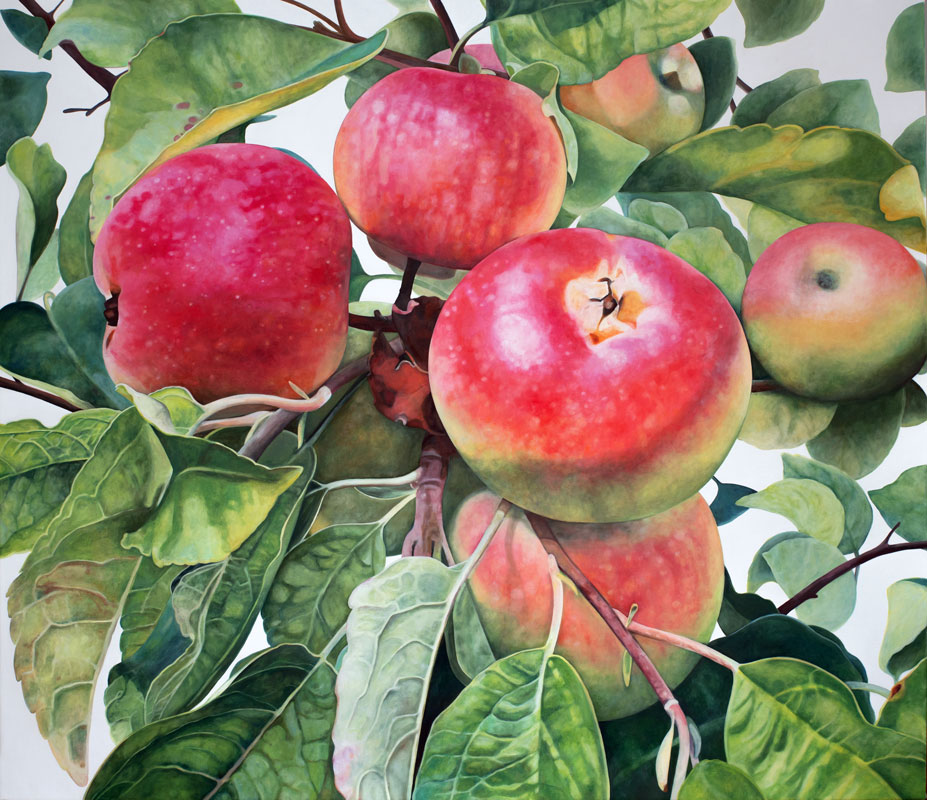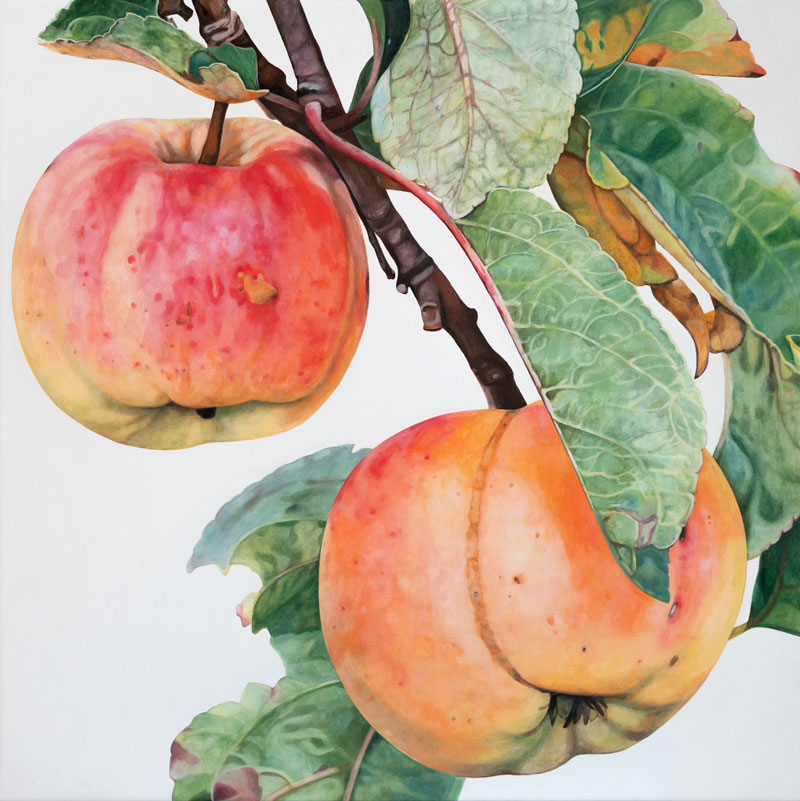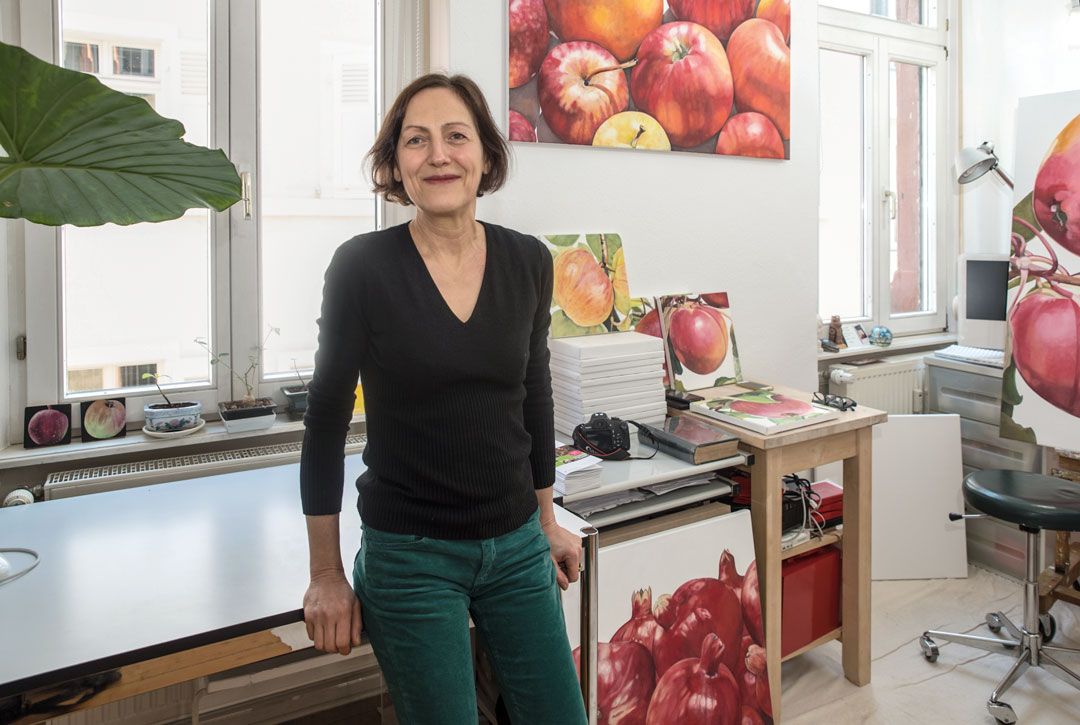Brigitte Hofherr’s portraits of old apple varieties
Brigitte Hofherrs Porträts der alten Apfelsorten
German artist Brigitte Hofherr was already attracted to nature, especially to plants, in her childhood and began drawing and painting from a very young age. Both as a painter and as a botanical artist, Brigitte is self-taught. She describes her exquisite paintings of heritage apple varieties.
My exhibition activities began in 1996 at the German Cancer Research Centre in Heidelberg, Germany. My paintings came to their attention, and they invited me to a winery in Stellenbosch, South Africa for a commissioned work. Trips to Greece, Italy, Turkey, Switzerland and France followed, during which I always pursued my passion of researching plants. This laid the foundation for a large archive of botanical photos and filled stacks of sketchbooks. I paint almost exclusively endangered and dying species and I am a member of the American Society of Botanical Artists and the Forum for Botanical Art Germany.
At the beginning of 2017, I visited New York. As a gift from an art collector there, I received a bowl of different interesting-looking apples with striking good taste. None of the apples were familiar to me. So I went to the Farmer’s Market in Greenwich Village. There I learned more about the apples and about the large apple-growing area in New York State. A short time later, the antiquarian first volume of the two books “Apples of New York” reached me at home by mail, which I treasure. In this book, I was fascinated by the autotypes and coloured collotype prints of the individual apple varieties.
Getting curious, I started to search further and found the website of the US National Agriculture Library with interesting information about apples and their origin, many of them which had been brought from Europe. I discovered that towards the end of the nineteenth century and in the first half of the twentieth century, many women were employed as illustrators on behalf of the USDA’s pomological division. I was particularly attracted to the watercolour illustrations of Mary Daisy Arnold, Amanda Almira Newton, Ellen Isham Schutt and Deborah Griscom Passmore.
Back in Heidelberg, I began to investigate where I could find historic apple varieties in the surrounding region and in Germany in general. To know more about the old varieties, I acquired pomological works and contacted nurseries for old varieties and enthusiasts for meadow orchards. The first interesting exchange was actually with the owners of a nursery of historic apple varieties located close to where I live.
When I was a child, one of my great uncles, who had studied horticulture, enthused me with his love of special fruit varieties. Since then, I had often been annoyed by the varietal poverty of the fruit around me. My work in the studio started to embrace this. After the first picture of a New York apple, the “Winesap”, I painted the first German apples, such as the “Lausitzer Nelkenapfel”, the “Sommerregent”, and the “Heidelberger Blutsapfel” which is a new breed from two old varieties, the already very old “Edelborsdorfer”, and the “Korbiniansapfel”.
At the same time, I delved into the works of German pomologists. I came across the Directory of Apple and Pear Varieties by Willi Votteler, published by the Bavarian State Association for Horticulture and Regional Conservation in 1986. In this reference work, apple varieties are described with their name, synonym, appearance, characteristics and origin. In addition, almost every variety is illustrated with a drawing by the priest, pomologist and great apple lover Korbinian Aigner.
As a politically committed pastor, Aigner was deported to the Sachsenhausen and Dachau concentration camps during the Nazi era.
There he bred, among other things, the so-called apple KZ3, the Korbiniansapfel. In the course of his life, he drew around 1000 varieties on postcard-sized cards, sketching his motifs in pencil and painting them with watercolours on thin cardboard such as old shoeboxes or similar materials. They are still used today by German pomologists to identify varieties.
Besides Aigner’s autodidactic but consistent illustrations, I find the small watercolours of apple varieties by Christophine Reinwald, Friedrich Schiller’s sister and daughter of the pomologist Johann Caspar Schiller, very distinctive and special. Johann Caspar Schiller was court gardener to the Duke of Württemberg at Solitude Palace and wrote the work “Die Apfelzucht im Großen”. Among other things, he published in this work his plans to provide all the avenues of Württemberg with fruit trees in order to avoid famine and to improve the bad air in the villages. His daughter provided him with corresponding illustrations of varieties in watercolour and seemed to have supported him in his written work as well.
In contrast, all my paintings are done with oil paint on canvas, mostly in large formats.
Where Elisabeth Dowle’s painting is very much based on the rules of botanical illustrations, the compositions often showing blossom, leaves, fruit and also branches from different seasons in one picture, I choose compositions that are basically a snapshot of the fruit. The painting shows the apple or the view into the section of the apple tree in a certain season, in a state influenced by weather, such as dryness and heat or cold, rain and wind. With the resulting compositions, I want to describe the characteristics of the variety and reflect them in the portrait.
However, in addition to the selection of objects, their arrangement and enlargement, I always keep in mind my wish that the finished picture should relate with the space on the wall and change it.
I build the stretcher frames for the canvases myself and choose primed fabric with a fineness appropriate to the size of the picture and the motif. I lay out the background with white oil paint with a wider brush. To assemble the composition, I use the photos and sketches I made of the tree and its’ apples. Mentally, I put together the individual parts of the material that are important to me.
This is a time-consuming process and requires the utmost concentration. Only what is to be seen later in the picture may be painted on the canvas as I will build up the painting in layers.
Additions can indeed be made later and are sometimes even necessary after examining a finished painting, so that the harmony of the composition becomes perfect. For this process I need diluted oil paint in a light shade and thin brushes. Then the real painting process begins.
With diluted oil paint, I start with the first layer and work in the usual method over the whole picture.
As I work, I remember the characteristics of the species created in the painting from the photographs and the written notes, as well as from the pressed leaves. The surfaces of the fruit, the leaves, the branches are supposed to appear tangible, tactile. The white background, without landscape or colour, allows the objects to come to the fore best for me, to gain presence. The painting thus acquires the objectivity that is important to me alongside all apparent sensuality.
After this step, the working process of glazing the individual layers of paint on the objects begins, which often takes weeks. To achieve the result I want, I patiently work my way towards the desired volume of the apples, the liveliness of the leaves and branches, the spatial effect of the entire painting and the light reflections and colourfulness of the work, in a process acquired through years of trial and error, until the painting corresponds to my ideas.
With fine light reflections on leaves and blossoms, the shiny or matt shimmering, sensual surfaces, I want to encourage the viewer to touch, even to want to bite into one of the tempting fruits.
While on the one hand the pictorial objects are reproduced almost photo-realistically, at the same time they are intended to have an almost monumental character due to their painterly representation in multiple enlargements. How much I care about the detailed and botanically correct reproduction of the fruits is reflected in the titles of the pictures, which are in Latin.
Otto Schmitz-Hübsch laid the foundation for commercial apple growing in Germany, planting orchards from 1896 onwards and by the 1950s, Korbinian Aigner realized that progressive agriculture had almost completely swept away the enormous diversity of old regional varieties, which differed from one another in colour, size, scent, taste and sweetness.
Hence my desire to paint portraits of as many as possible of the old varieties, die alte Apfelsorten, discovered on my travels and through contact with apple lovers, pomologists and orchard owners. Since the large paintings require a lot of time, I began a parallel series of small-format works on squares of recycled pitchpine wood, small “apple icons”, as I like to call these pictures.
In March 2023, the paintings of the ‘historical apple varieties’ will go on display at the German Horticultural Museum in Erfurt, Germany.
I have recently been painting historical tomato varieties for an exhibition in Nafplion, Greece.
These paintings also contain a message – to know and love diversity and to protect it with pleasure. A part of the proceeds of the works sold will go to the “Peliti” community to build up the first Greek seed bank.
In the past few years, during stays in my summer house in Greece, I have researched native plants that are important in history, mythology, art but also in today’s everyday life. Pictures were also created on this theme. That series will also continue to grow, alongside my apples.
Literature:
The Apples of New York
State of New York – Department of Agriculture
Volume I
1905
Index of apple and pear varieties
W. Votteler
Fruit and Horticultural Publishing House Munich 1986
Johann Caspar Schiller
Arboriculture on a large scale
Ulmer 1993














 Yosuke Amemiya and the search for the Universal Apple
Yosuke Amemiya and the search for the Universal Apple The apple label art of Anne Rook
The apple label art of Anne Rook